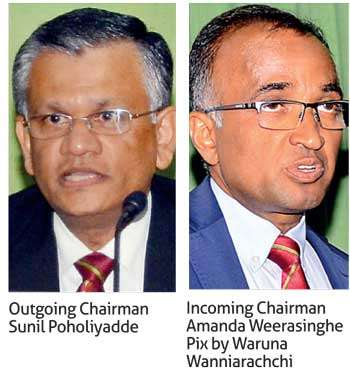20 Jul 2018 - {{hitsCtrl.values.hits}}
 By Shabiya Ali Ahlam
By Shabiya Ali Ahlam
Sri Lanka’s struggling rubber industry yesterday urged the government and relevant authorities to give due attention by looking at means to boost productivity, a key aspect that remains to be actively addressed that would ensure the industry’s sustenance.
The Colombo Rubber Traders’ Association (CRTA) during its 99thAnnual General Meeting (AGM) held in Colombo, yesterday, reiterated the need for the authorities to take “serious” note of the industry issues and take active steps to rectify them.
Alongside the effect of climate change, key issues faced by the industry include non-availability of skilled tappers and restriction of land availability for cultivation in traditional rubber growing areas. The delayed response to the repeated calls for help by stakeholders has resulted in poor production.
“Looking at the future of the industry I see many threats to the natural rubber industry as well as many opportunities that could be explored for its development. At least 4 percent of the population is dependent on it so it is necessary to focus on improving the current situation,” said the outgoing CRTA Chairman Sunil Poholiyadde.
It was suggested that to tackle the lack of labour issue, imperative is to look at increasing productivity and reducing costs with high yielding and better maintained plantations.
Pointed out was also the need to assist smallholders in improving the quality of RSS produced, so they will be able to fetch higher revenues and be encouraged to remain in the industry.
Currently, majority of smallholders (who contribute to almost 70 percent of the natural rubber production) supply low quality RSS to tyre manufacturers.
It was stressed that the Rubber Research Institute (RRI) and the Rubber Development Department step up their efforts in this regard.
In the recent years, it has been oberved that many of the rubber growng areas have been urbanised and industrialised.
With regard to the corporate sector, the outgoing chairman pointed out that threat faced is largely on lands being acquired. It was shared that over 4000 acres of high production rubber land is to be acquired, and the move will only weaken the industry further unless there is a solution for rubber to be rapidly grown in the non-traditional areas.
With several areas already been identified as suitable for rubber cultivation, Poholiyadde opined that the opportunity should be made available to the corporate sector as well, as it has the strength to invest.
While reflecting similar sentiments, the incoming chairman Amanda Weerasinghe said the industry requires the adoption of new technologies and the political will to gather momentum.
The CRTA annual report 2017/2018 shows that rubber production for 2017 grew by 5.1 percent to 83.1 million kgs from 79.1 million kgs recorded the previous year.
The growth in natural rubber production was achieved amidst unfavourable weather conditions, particularly during the first half of the year where traditional rubber growing areas were hit with severe floods.
Despite the increase in production, domestic consumption declined by 9.2 percent in 2017 from 142 million kgs to 128 million kgs.
With regard to cultivation, 208.8 hectares were newly planted in traditional rubber growing areas and 464.4 hectares were newly planted in non-traditional rubber growing areas.
In terms of exports, natural rubber exports were increased by 6.6 percent to 17.2 million kgs in 2017 compared to the previous year.
Total export value recorded an overall increase of Rs.1,162 million 2017 compared with 2016. During the said period, export value of RSS was increased by Rs.544 million.
17 Nov 2024 17 Nov 2024
17 Nov 2024 17 Nov 2024
17 Nov 2024 17 Nov 2024
17 Nov 2024 17 Nov 2024
17 Nov 2024 17 Nov 2024